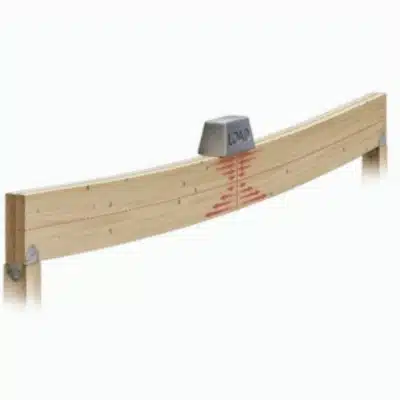Gap Between Floor And Wall
Gaps between your home’s floors and walls can result from the foundation settling into poorly compacted, moisture-softened, or shrunken soils beneath the structure.

Gap Between Floor And Wall Repair in Northern Virginia, Shenandoah Valley, North Central Virginia, and West Virginia
If you spot a gap between the floor and wall in your home, it may indicate signs of foundation issues. The soil in the ground can expand or contract due to precipitation and temperature changes, causing the foundation to shift or settle. This movement can lead to interior damage, including floor and wall gaps.
These unpleasant gaps are not only distressing but also indicative of deeper structural issues within your home that need to be addressed to avoid further damage. Ignoring them could escalate problems, as the root cause is unlikely to fix itself.
To prevent any additional harm to your home, contact LUX Foundation Solutions at your earliest convenience for expert advice. We offer free estimates to homeowners in Northern Virginia, Shenandoah Valley, North Central Virginia, West Virginia, and surrounding areas.
Do These Signs of a Gap between the Floor and Wall Seem Familiar?
The symptoms
If you suspect foundation problems in your home, keep an eye out for these common signs of a gap between the floor and wall:
- Cracks in walls or ceilings that extend from the floor to the ceiling
- Gaps between floors and baseboards or walls
- Doors or windows that stick or don’t open/close properly
- Uneven or sloping floors
- Separation of floor tiles or hardwood planks
- Visible cracks in the concrete slab foundation
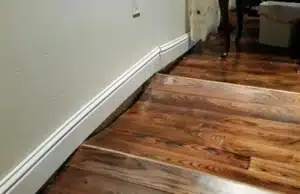
Uneven floors

Cracks in walls or ceilings
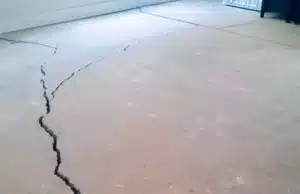
Visible cracks in the concrete slab foundation

Separation of hardwood planks
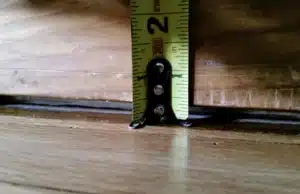
Floor gaps

Doors that stick
What Causes Gap between Floor and Wall
Various factors can contribute to a gap between the floor and wall in a building. The most common causes include:

Sinking or Damaged Foundation
A sinking or damaged foundation is one of the most common causes of gaps between the floor and wall. One indication of this is if the gaps gradually grow, indicating that your home’s foundation is starting to settle unevenly. When this happens, gaps can form around doors and windows, in corners, and between walls and floors.
Damage can occur due to factors like earthquakes, soil erosion, or the natural aging of the foundation. When the foundation sinks or shifts, it can pull away from the walls, causing a gap.

Rotting or Damaged Floor Joists
Floor gaps can also occur when your floor joists start to rot or suffer from other water damage. This damage can happen due to a lack of insulation or encapsulation in the crawl space, which allows moisture to collect and cause wood rot.
If you notice that your floors are starting to slope or sag or hear creaking noises when walking across the room, it could indicate rotting floor joists.

Improper Crawl Space Support
If your home’s crawl space is insufficiently ventilated or lacks the necessary support structures, the weight of the house can cause it to shift and move, creating gaps between the walls and floors.
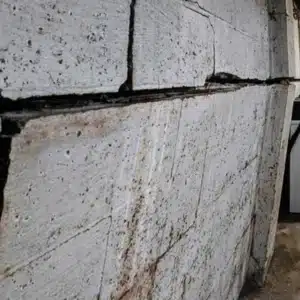
Bowing Walls
When walls start to bow and bulge, gaps can form between the walls and floors. This issue is typically caused by excess water pressure around the foundation or a poorly constructed foundation. If your home is located in an area with high water levels or heavy rainfall, inspect your basement walls for any signs of bowing.
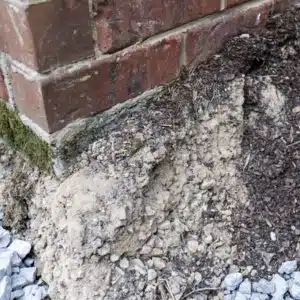
Soil Movements
Soil can expand or contract due to its moisture content, leading to movements in the soil underlying the foundation, causing it to shift. As the foundation moves, it can cause the walls to crack and separate from the flooring, creating visible gaps. Moreover, soil movements can also shift a foundation’s weight distribution, leading to uneven floors.
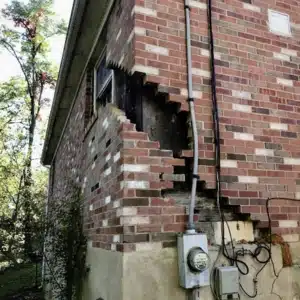
Foundation Settlement
The soil beneath a building can compress or shift over time, causing the foundation to settle unevenly. It can happen due to changes in the soil’s moisture content, poorly compacted soil, or inadequate foundation design. As the foundation settles unevenly, it can pull away from the walls, leading to gaps between floor and wall.

Soil Moisture Changes
Changes in soil moisture levels can have a significant impact on the foundation. Excessively dry soil can shrink and create voids beneath the foundation, while overly wet soil can expand and exert pressure on the foundation walls. Poor drainage, improper grading, or shifts in the local water table can all contribute to soil moisture changes that lead to a gap.
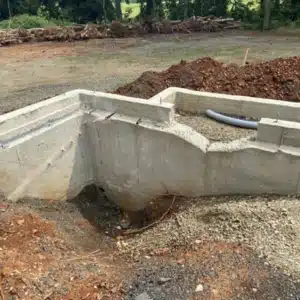
Poor Construction
When a foundation is poorly constructed, it may lack the necessary reinforcement, be built with subpar materials, or suffer from improper installation of foundation components. Over time, these issues can manifest as structural problems, including the separation of the floor from the wall, creating a visible gap.
At LUX Foundation Solutions, we understand the various causes of the gap between the floor and wall and have the expertise to address them effectively. Our team will evaluate your specific situation and provide tailored solutions to restore the stability of your foundation.
Our Solutions
If you are experiencing a gap between the floor and wall due to sagging, you will likely need to replace your main beams. The main beam is a critical structural component that supports the weight from the roof to the foundation. Over time, it can weaken or deteriorate, leading to sagging and cause uneven weight distribution, leading to gaps in your walls or floors.
By replacing the main beam, you restore the structural integrity of the floor system and eliminate the sagging, which helps close the gaps. This repair involves identifying the damaged main beam, removing the old beam, and installing a new, properly sized, supported beam.
Yes, a gap between the floor and wall of your house can be a sign of a foundation problem. These gaps may indicate that your foundation is settling unevenly, which, if not addressed, can lead to serious structural issues.
As the floor and wall start to separate, you need a sturdy solution to push them back together to remove the void. Push piers are effective for repairing floor and wall gaps. These tube steel piers are driven deep into the ground below the foundation to transfer the structure’s weight to stable soil. Not only will this remove the gap, but it will also lift and stabilize the foundation to its original position and prevent future problems.
If you have a gap between the floor and wall in your house due to damaged floor joists, it is necessary to perform repairs to prevent further damage. Floor joists are long horizontal wooden beams that provide support for the floor in your house. As this deterioration progresses, the floor joists lose their ability to bear the weight of your home, potentially leading to a separation between the floors and walls.
The solution to this problem is floor joist sistering. This involves attaching new joists next to the existing weakened joists, which adds strength and stability to the floor. It is vital to address this issue promptly, as weakened floor joists can cause structural damage and compromise the house’s safety.
Yes, wall anchors can fix the gap between the floor and wall without disrupting the rest of the house by using wall anchors. Wall anchors secure the walls to the floor or ceiling, providing stability and preventing further movement. They work by anchoring the wall to the ground through a metal plate and rod inserted into the hole and screwed in place.
By strategically placing wall anchors, it can close the gaps without the need for extensive demolition or reconstruction. This solution is effective because it targets the specific problem areas while minimizing disturbance to the surrounding structures, saving time and cost in the repair process.
How to Fix Large Gap Between Wall and Floor? Choose LUX Foundation Solutions for Permanent Foundation Repairs
There are solutions available to address the gap between the floor and wall quickly and efficiently, despite the initial shock that may arise from encountering them.
If you have come across floor gaps, don’t worry. Our foundation experts can solve this problem quickly and efficiently. Our team is dedicated to protecting your home from foundation damage to ensure it stays safe for years to come. We’re committed to fixing any foundation issues, no matter how small or big they are.
We proudly serve homeowners in Northern Virginia, Shenandoah Valley, North Central Virginia, West Virginia, and surrounding areas. Discover more about our foundation repair services and request a free estimate by contacting us today at 540-508-8982 or fill out our online estimate request form to schedule a free, on-site foundation estimate!
Request a free Estimate
FAQ's
If you notice gaps between the floor and wall in your home, addressing them as soon as possible is essential. These gaps may indicate a foundation problem, leading to severe structural damage. Addressing it can increase the safety of your home and prevent further damage that may impact the value of your property. If left unaddressed, these issues can compromise the integrity of your home and be costly to repair.
It is recommended to seek the assistance of a foundation repair service to inspect your home and identify any underlying issues causing these gaps. By taking action early, you can avoid costly repairs and ensure the longevity of your home.
Yes, there are safety precautions you can take to minimize the occurrence of a gap between the floor and wall due to foundation problems:
- Ensure that your drainage system is working properly and that there is no water accumulation near the foundation. This can be achieved by maintaining gutters and downspouts, adding drainage pipes, and grading your yard away from the foundation.
- Avoid overloading your foundation with excessive weight, especially around areas without support.
- Maintain proper moisture levels in the soil around the foundation by implementing proper drainage systems.
- Have your foundation inspected regularly by a qualified expert to detect any early signs of settlement and avoid further damage.
Following these steps can help minimize the likelihood of floor and wall gaps due to foundation problems.
If you are experiencing a gap between the floor and wall, it is essential to understand that this is likely a symptom of an underlying foundation problem. While patching up the cracks may seem like a quick fix, it will not address the root cause, and the gaps may reoccur and worsen over time.
Ignoring an underlying foundation problem can lead to further structural damage and safety hazards within your home. To ensure a long-term solution, it is crucial to contact a reputable foundation repair service to identify the main cause of the issue and prevent further damage to your home.
Gaps between the floor and wall are common signs of foundation problems, and if not addressed promptly, they can lead to more serious issues. These gaps can be caused by various factors such as soil movement, settlement, or poor construction. When left unattended, the gaps can become wider, presenting safety risks and compromising the structural integrity of your home.
It is important to seek expert foundation repair services to identify the underlying problems causing the gaps and to implement appropriate measures to restore your home’s safety, stability, and value.



